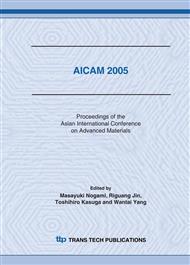p.521
p.525
p.529
p.535
p.539
p.543
p.547
p.551
p.555
Titania Nanotubes Prepared by Templating Needle-Like Calcium Carbonate
Abstract:
Titania nanotubes were successfully synthesized by a simple procedure with needle-like CaCO3 as inorganic templates at a room temperature in nonaqueous system. Through the hydrolysis of tetrabutoxytitanium (TBOT), titania crystal nucleus were deposited on the CaCO3 nanoparticles due to heterogeneous nucleation, followed by aggregation condensation on the surface of needle-like CaCO3 cores and removal of CaCO3 to produce hollow titania nanotubes. Its morphological and structural properties were characterized by TEM, SEM, and XRD, respectively. The nanotubes have a uniform tubular hollow structure with one or two big openings ends, the length of about 2.0 μm, the average inner diameters of 100-200 nm, respectively, and a wall thickness of approximately 40 nm. The phase formed was anatase after calcinations at 723 K for 2 h and nanotubes with hollow structure remained their original shapes, and the BET surface area of as-synthesized titania nanotubes was 243.45 m2/g, and decreased to 144.76 m2/g after calcinations
Info:
Periodical:
Pages:
539-542
Citation:
Online since:
February 2006
Authors:
Keywords:
Price:
Сopyright:
© 2006 Trans Tech Publications Ltd. All Rights Reserved
Share:
Citation:


